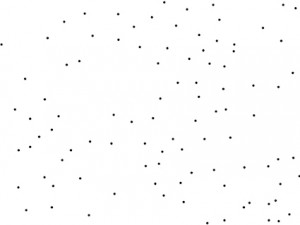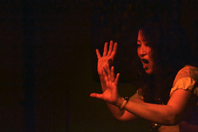Wajid Yaseen
DotScore#16
DotScore#16 is a graphical music score brought about from an exploration into Number-Form synaesthesia, in particular a recently identified sub-type referred to as Magnitudal-Spatial synaesthesia.
Magnitudal-Spatial synaesthesia suggests an innate number-form perception that involves not only the visualisation of numbers mapped into distinct spatial locations, as typically experienced by number-form synaesthetes, but includes non-symbolic magnitudes such as sizes, length, clusters, and even luminance.
DotScore#16 brings these non-symbolic magnitudes into play by specifically highlighting the cluster distribution information generated by the image analysis of a photograph taken in the city of Palermo in Sicily as part of a series of musical (photo)graphic scores. The project involves the transposition of architectural space to sound space revealing continuity, connectedness and convergence; something akin to a “Sonic Topology”.
Reflecting the diverse and idiosyncratic nature of cognitive synaesthesia, DotScore#16 is accompanied by musical and sonic interpretations of the score by the following artists :
Yumi Hara Cawkwell
Charles Poulet
Gisle Frøysland
Martin A. Smith
Charles Hayward
Alice Kemp
Helen Frosi
James Cauty
Colin Hacklander
Farah Hatam
Guy Harries
Yumi Hara Cawkwell
0m:30s
“I regarded the dots as visual guides and inspiration for performance. but in a way, quite traditional…higher the space higher the pitch, distance between the dots as duration, more or less. exact pitches and durations are left to me, the performer.”
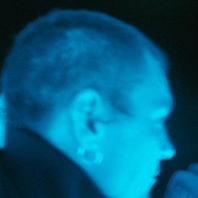
Charles Poulet
5m:23s
“Looking at the score I decided I needed a meter which I created using no input on my mixer. This gave me a click that is recorded, and is in the mix, and I then recorded the piano part. I rehearsed it a couple of times but it was done in one take.
I just stared at the dots and picked out a pattern letting them guide me. I am not a piano player. I went round the score a couple of times, I think as long as the base click track was running. I read the score bottom left to right, then right to left, and so on making my way up, then I think I went around. The build is based on reading the empty space and the main void in the score – it has that sense of oblivion that is represented within the space in between…
I also used a gate to cut up some feedback from a filter that is triggered by the click and reverb feedback, so there is a sense of motion that is not controlled. It’s part of the meter or time itself progressing within the dots … “
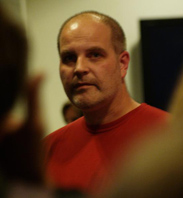
Gisle Frøysland
1m:03s
“Instead of trying to interpret the visual image of the dots, I decided
to focus on the digital information in the file. As a long time Linux
user, I love the ability of Unix-based systems to treat everything as
files. That way you can send all kinds of files directly to the sound
output (/dev/dsp). The easiest way of doing this is to use the
aplay/arecord command line programs:
aplay -c 2 -r 22050 -f mu_law foobar.jpg | arecord -f cd -t wav
foobar.wav
Several different wav files were recorded using this oneliner with
various parameters for sample rates and formats. These were all put
together and mixed using Audacity to get the end result that I wanted.”
Martin A Smith
4m:15s
“My initial response when I first saw the given score was that it reminded me of a child’s join the dots picture. I thought about other interpretations but I kept coming back to the idea of a child’s drawing. So deciding that this was the approach I would take I gave a printed copy of the score to my seven year old nephew and asked him to do a drawing of anything he wished by joining up the dots. What he presented me with was a picture of a dog jumping through space. (I like the way he added an extra dot to make the picture work!). I then wrote a piece which was a literal response to this drawing, asking myself “What would this picture sound like?”
All the sounds you hear are recordings of dogs which have then been manipulated to create the final work.”
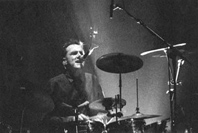
Charles Hayward
0m:58s
“I started work on the score with no preconceptions and tried to follow the implications of the piece as the work unfolded. Very quickly the score suggested cells of information, clusters discreet each from the other, although this would melt and slightly re-configure from take to take. Eventually I made eight versions of the dotscore, using the same drum kit and microphones but changing between sticks, mallets, brushes and brooms (a variation of ‘hot-rods’ made for me by Ashleigh Marsh). I then selected the two interpretations that most clearly traced each other, deciding on a version utilising brushes, another using the brooms and a third that is a super-imposition of both performances. Presented here is the ‘brush’ version.”
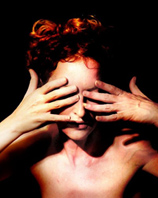
Alice Kemp
1m:15s
“Tools used:
SM58 microphone
pencil
steel ruler
editing & sequencing software
I wanted to try and create a sensation of being within the dots at the centre of the score without working ‘left to right’ or any other linear configuration. Originally I was thinking to record the dropping of a bag of marbles, and although the idea was pleasing and made some kind of visual sense to me, I decided not to pursue it for one reason or another.
I identified a central point in the score – a place without dots – and recorded the sound of a line being drawn from that point to each of the dots in the score. There are 95 dots so 95 separate lines of varying length were drawn, recorded, edited, pitch shifted up (to make the sounds appear ‘smaller’) and sequenced.
Whilst sequencing the sounds I still felt slightly trapped by a sense of ‘working left to right’ instead of ‘from the middle outwards’ so to counter this, in some way, I deliberately didn’t align a dot-to-sound sequence – I organised the sounds in a way that attempted to emulate the idiosyncratic bodily and mental sensations that the score presented to me.”
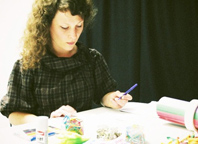
Helen Frosi
10m:51s
“Constellations 89-105
[a7; b6; c8; d7; e8; f5; g5; h5; i6; j5; k6; l9; m3; n7; o5; p5]
On first inspection the score resembles an unfinished star chart.
As the mind desires to create order from chaos, I began to bring together shape and form within this ‘image of the heavens – creating constellations of my own imagining (thus nos. 89-105, sixteen additions to the eighty eight recognised constellations).
Architecturally, the piece is constructed from the placement of each constellation (collection of linked dots) in the firmament (the page). Sonically, the score derives its cadence from the number of stars in each constellation. Here I use artistic licence as I may have seen stars on clear nights, but I don’t remember ever having heard them. In my imagination they sound like fireworks, or possibly a detuned Appalachian dulcimer…”

James Cauty
0m:14s
“un-looped version
4/4
120 bpm
14 sec
protools 7
.wav
writers : Cauty/Beethoven copyright control
method :
1: random selection of sound…itunes first track in list…Beethoven 9th (a clockwork orange version)
2: copy dots to photoshop and overlay grid and assign centre line as middle C
3: edit sound file down to blip. re sample. time stretch etc etc
4: cut and paste dots to midi track…this didn’t work…fuck…copy dots to audio track manually using grid to represent bars and notes…pitch shift to match note position on grid
5: bounce track, re import and pitch shift…twice
6: export finished composition”
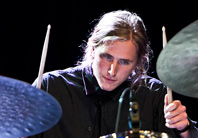
Colin Hacklander
1m:50s
“Score-interpretation & performance as multi-track recording using drums & percussion in 7 tracks. Software used: Max/MSP (as score for computer/human communication) and Audacity (DAW). Recorded at NK Projekt in Berlin, DE.
NOTES TO SELF/TRANSLATING DOT SCORE
-Trace dots onto graph paper.
-TIME is x-axis
-Each box = 3000 ms
-Divide clusters into 7 layers (i.e., 7 tracks). Colour each layer for clarity.
-simple Max/MSP patch:
-program events (dots) in time according to score; button flashes yellow to signal HIT!
-separate list for each track
-Each layer played live with unique drum and/or mic placement
-5 seconds of silence at beginning & 15 at end.”
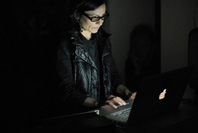
Farah Hatam
3m:36s
“A central dot is used as a starting point for the trajectory of lines that are drawn moving outwards from the centre. These lines (54 in total) and their movements are translated into frequency lines: i.e. whether a pitch increases or decreases over time. Once the frequency lines have reached their final state they stop sounding. Time is calculated along the X-axis using this central dot as the point of reference.
The sound synthesis is programmed in SuperCollider using the Saw Ugen, and is made up of 54 frequency lines. The score is divided into sections; the panning of the sound (right channel, left channel, mono centre, centre right, or centre left) is decided by the final point of each line.”
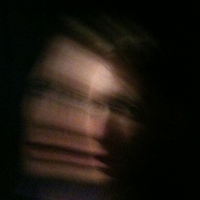
Guy Harries
3m:08s
“The interpretation of the dot score was realised through a series of ‘journeys’ through the page. Using an analog Korg Monotron synth, sounds were played as an impression of the page, with my eyes travelling, not according to any system, but rather attaching themselves to certain groupings of dots suggesting circular repetition or descending and ascending lines. The dots were represented as short sound events, with the vertical axis mapped into a (quite flexible) impression of pitch. In addition to this, I made several ‘journeys’ in which I focused on the blank part of the page, regarding it as a viscous liquid material oozing and spreading through the dot structure, at times more restricted and at other times free to spread across a wide area and manifest itself in sound.”
